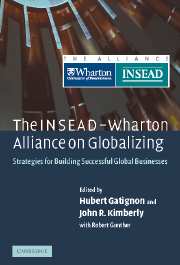Book contents
- Frontmatter
- Contents
- List of figures
- List of tables
- Notes on contributors
- Foreword
- Acknowledgments
- 1 Globalization and its challenges
- Part I Leading the global organization
- Part II Global market participation
- Part III Managing risk and uncertainty
- 11 Cross-border valuation: the international cost of equity capital
- 12 Managing risk in global supply chains
- 13 Global recombination: cross-border technology and innovation management
- 14 From corporate social responsibility to global citizenship
- 15 Colliding forces: domestic politics and the global economy
- 16 Global implications of information and communication technologies (ICT)
- Part IV Implications and conclusions
- Author index
- Subject index
13 - Global recombination: cross-border technology and innovation management
from Part III - Managing risk and uncertainty
Published online by Cambridge University Press: 14 January 2010
- Frontmatter
- Contents
- List of figures
- List of tables
- Notes on contributors
- Foreword
- Acknowledgments
- 1 Globalization and its challenges
- Part I Leading the global organization
- Part II Global market participation
- Part III Managing risk and uncertainty
- 11 Cross-border valuation: the international cost of equity capital
- 12 Managing risk in global supply chains
- 13 Global recombination: cross-border technology and innovation management
- 14 From corporate social responsibility to global citizenship
- 15 Colliding forces: domestic politics and the global economy
- 16 Global implications of information and communication technologies (ICT)
- Part IV Implications and conclusions
- Author index
- Subject index
Summary
In a knowledge age, the flow of ideas and innovations around the world is essential to business growth and renewal, but also poses complex management and design challenges. How can companies manage the process of global innovation? This chapter examines the issue of “global recombination,” moving ideas from one part of the world to another or combining sets of ideas into innovations. The challenge is that while knowledge must move globally, it is still often contained within tight, geographically anchored communities. The authors identify four essential elements for making recombination work: access to diverse knowledge elements; the capacity to absorb knowledge from communities of practice; the ability to adapt such knowledge to different local contexts before recombining it; and ensuring that localized pockets of knowledge are integrated so that recombination actually takes place. The authors provide frameworks for managers to explore how their enterprises are positioned to recombine knowledge that already exists to create value for customers and wealth for the enterprise.
The original pioneers of the plastics industry were blindsided by a set of actors from outside their community. These pioneers in plastics were chemists who saw plastics as a high-end product that was a replacement for dwindling natural supplies of rubber, shellac, and ivory. To make the first plastic, a British scientist modified nitrocellulose (which in a particular form is guncotton) to create Celluloid.
- Type
- Chapter
- Information
- The INSEAD-Wharton Alliance on GlobalizingStrategies for Building Successful Global Businesses, pp. 306 - 330Publisher: Cambridge University PressPrint publication year: 2004
- 1
- Cited by

